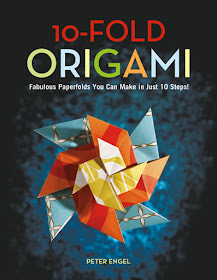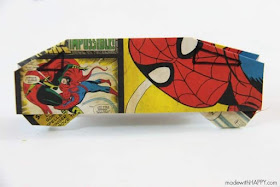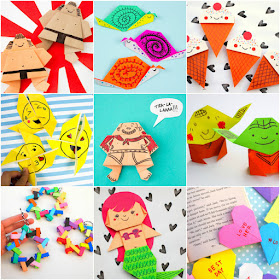We are on our third week of exploring Japan for Asian Pacific American Heritage Month. If you missed our first two weeks we did new picture books to learn about Japan and crafts from Japan. Today we are taking a look at the ancient art of Japanese origami. I thought I would start with some fun facts since I shared a bit about the history of origami a few years ago.
Fun Facts about Origami
1. The word origami is derived from two words ori meaning folded and kami meaning paper. It was called Orikata previously which means folded shape.
2. The Japanese word for paper “kami” is written the same as the Japanese word for spirit or god. Certain origami models were part of their religious ceremonies.
3. Samurai would give each other noshi which were paper folded with a strip of fish. These were considered good luck tokens.
4. Traditional origami does not permit any cutting and only uses square paper.
5. The smallest origami crane on record measured 0.1 by 0.1 mm and was folded by Naito Akira. The largest origami crane measures 256 feet 6 inches.
6. Origami plays an important part of Japanese wedding rituals. There is a presentation of 1000 paper crane during the wedding. There are two ways it can be done. The first is the practice of sembazuru where the couple folds the cranes themselves. The cranes are strung and used to decorate the wedding hall. The other tradition is the father of the bride gift the 1000 cranes to his daughter.

7. The first origami book was written in 1797. It was Sembazuru Orikata by Akisato Rito.
8. Paper folding began in China in the 1st or 2nd century. It came to Japan in the 6th century.
9. The first origami models looked similar to things. They were often given to people for good luck.
10. Origami toys were developed by the Chinese including the famous waterbomb.
11. Practicing origami activates the brain and it develops coordination, patience, attention span, mathematical skills, symmetry understanding and more!
2. The Japanese word for paper “kami” is written the same as the Japanese word for spirit or god. Certain origami models were part of their religious ceremonies.
3. Samurai would give each other noshi which were paper folded with a strip of fish. These were considered good luck tokens.
4. Traditional origami does not permit any cutting and only uses square paper.
5. The smallest origami crane on record measured 0.1 by 0.1 mm and was folded by Naito Akira. The largest origami crane measures 256 feet 6 inches.
6. Origami plays an important part of Japanese wedding rituals. There is a presentation of 1000 paper crane during the wedding. There are two ways it can be done. The first is the practice of sembazuru where the couple folds the cranes themselves. The cranes are strung and used to decorate the wedding hall. The other tradition is the father of the bride gift the 1000 cranes to his daughter.

7. The first origami book was written in 1797. It was Sembazuru Orikata by Akisato Rito.
8. Paper folding began in China in the 1st or 2nd century. It came to Japan in the 6th century.
9. The first origami models looked similar to things. They were often given to people for good luck.
10. Origami toys were developed by the Chinese including the famous waterbomb.
11. Practicing origami activates the brain and it develops coordination, patience, attention span, mathematical skills, symmetry understanding and more!
Sources:
- Kiddle Encyclopedia. “Origami Facts for Kids.” (18 Apr 2020) https://kids.kiddle.co/Origami
- Mehta, Deepak. Quora. “What are some mind blowing facts about origami?” (20 Jan 2013) https://www.quora.com/What-are-some-mind-blowing-facts-about-origami
- Mocomi. “Origami.” https://mocomi.com/origami/
- Tar, Violet. BabaMail. “5 Interesting Facts about Origami.” https://www.ba-bamail.com/content.aspx?emailid=32980
Now we see a reason to practice and teach origami ourselves and to our children. I have some fun resources to learn and try origami to share today. Let's start with Fun & Easy Origami Animals by Michael G. LaFosse.
This book has instructions to make 19 animals. It also comes with 20 sheets of solid color origami paper to try making the animals with. The instructions are pretty easy to follow. It includes instructions to make the traditional crane as well as the flapping bird and other favorites.
I tried making a few of the animals like the jaguar.
I tried making a few of the animals like the jaguar.
I also tried the flapping bird.
This book is a great one for beginners or to do with kids. The projects are pretty easy and the instructions are pretty clear. Plus most kids love making the different animals! And it comes with the paper to try the projects.
Our next product is a kit so it has everything you need to make and play some origami games. It is Origami Games for Kids Kit by Joel Stern. Now the projects in this kit are not traditional origami because they use rectangular paper. It comes with the paper. The games include leap frog, balancing act, basket bombs, chip toss and more. There are a total of fifteen games in the book.
This kit has some fun games for kids to play with their easy to make creations. The instructions are very clear and easy to follow. The projects are on the easy side as well. I love that it gives a use to the origami since so often people do not know what to do with completed origami projects.
Our next book is a fun take on origami and kids will love it! It is Secret Message Origami from Odd Dot. There are two pages of instructions and then 120 pages of perforated origami papers. Each paper is themed with things from cupcakes to game console and unicorns. Lots of choices for all types of kids.
The concept is pretty easy. First you do the secret fold instructions and write your message
and more on the back side!
Our next book has interesting projects in it that I have not seen elsewhere. It is 10-Fold Origami by Peter Engel. The projects in this book can be made in just ten steps! The book is divided into five chapters: Traditionals, Delectables, For the Romantic, Wild Kingdom, and Just for Fun. It includes things like a house and a pinwheel (see below with the flowers), eggs and bacon, picture frames and more!
I made a traditional crane from an sheet of paper from Origami Paper 200 Sheets Kimono Patterns. And I made the elephant head using the solid side of a paper.
The instructions were clear but some required certain colors of paper to make look realistic like the bacon and eggs. It does not come with papers.
Our final book is not for beginners. It is Naomiki Sato's Origami Roses. The roses and flowers in this book are beautiful. Most require 50+ steps to create them. I started one but did not have the patience to finish it. There are 16 different flowers in this book.

However the projects are absolutely gorgeous. Many of them look real!!
I attempted the simple square rose. Like I said my patience got the better of me. I will try it again sometime though when I really have time to sit down and concentrate which is not right now.
This got me to thinking about the origami I made when I was a child. I remembered making flowers and a vase. I had some origami paper and some beautiful gift wrapping paper to review. I thought I would make some flowers from the Origami Paper 300 Sheets Tie Dye Patterns and a vase (or two) from the Cool Blue Gift Wrapping Papers since they look like porcelain designs.
Now the wrapping papers are beautiful and certainly would be gorgeous on a gift but I love using the quality paper for crafts and this is quality paper. They share some crafts and sample wrappings using the paper in the pages before the wrapping paper.
I used this tutorial for the vases and then did some different flowers.
I made a tulip using this tutorial and made the stem and leaf out of a solid green paper.
I used some of the tutorials here for the different flowers and made a pinwheel from 10-Fold Origami. As always the origami paper was wonderful and I love the various color combinations. I also have been putting together donation bags for frontline workers that have been donated by my VIP customer group for Thirty-One. I decided to make these cards with origami hearts on them. I used the Origami Paper 300 Sheet Tie-Dye Patterns and Origami Paper 300 Sheets Nature Photo Patterns.
I printed the cards on postcards. Here is a close up on one of them.
The bags are filled with treats and I wanted to make sure they knew we appreciate them. What do you think?
1) Pen pots from Blue Bear Woods
2) Pencil holder
3) Butterfly book mark from Red Ted Art
4) Harlequin cubes (part of Geometric Origami)
5) Bunny from Red Ted Art
6) Boats from Kids Craft Room
7) Boats from Fireflies and Mud Pies
8) Fun birds from Red Ted Art
9) Star
10) Firefly
11) Cardinal
12) Heart bouquet from Ruffles & Rain Boots
13) Fish from Red Ted Art
14) Geometric Star
15) Window Flower Star from Rainy Day Mum
16) Butterflies
17) Penguins
18) Color Yourself Crane (this one is still sitting on a shelf in my bedroom because I love how it came out)
19) Whales from Red Ted Art
20) Bird Finger Puppets from Red Ted Art
21) Tulip
22) 3-D Tree
23) Origami car from Made with Happy
Also I have to share this amazing round up from Pinky Stripe Socks. There are over 50 different links to her origami tutorials. They are so fun and such a variety!
So that is our look at origami! I hope you will check out the projects and the products. It is a great activity to do with your kids especially while staying safe at home. You can pick up some origami paper on-line or cut your own squares! Enjoy!!
This book is a great one for beginners or to do with kids. The projects are pretty easy and the instructions are pretty clear. Plus most kids love making the different animals! And it comes with the paper to try the projects.
Our next product is a kit so it has everything you need to make and play some origami games. It is Origami Games for Kids Kit by Joel Stern. Now the projects in this kit are not traditional origami because they use rectangular paper. It comes with the paper. The games include leap frog, balancing act, basket bombs, chip toss and more. There are a total of fifteen games in the book.
This kit has some fun games for kids to play with their easy to make creations. The instructions are very clear and easy to follow. The projects are on the easy side as well. I love that it gives a use to the origami since so often people do not know what to do with completed origami projects.
Our next book is a fun take on origami and kids will love it! It is Secret Message Origami from Odd Dot. There are two pages of instructions and then 120 pages of perforated origami papers. Each paper is themed with things from cupcakes to game console and unicorns. Lots of choices for all types of kids.
The concept is pretty easy. First you do the secret fold instructions and write your message
and more on the back side!
Then you unfold the paper. The message looks all scrambled. The messages themselves look better in big letters but work if with small letters if you want to write more of a message.
Then you fold the paper in the decoy fold. The papers that come with the book have pictures that come together on one side of the decoy fold (and often have a whole picture on the other side).
Now you pass the note to your friend. Your friend then unfolds it and does the secret fold to read the message. Of course it requires you and your friend knowing the secret fold, but it gives note passing an extra level of fun!
Our next book has interesting projects in it that I have not seen elsewhere. It is 10-Fold Origami by Peter Engel. The projects in this book can be made in just ten steps! The book is divided into five chapters: Traditionals, Delectables, For the Romantic, Wild Kingdom, and Just for Fun. It includes things like a house and a pinwheel (see below with the flowers), eggs and bacon, picture frames and more!
I made a traditional crane from an sheet of paper from Origami Paper 200 Sheets Kimono Patterns. And I made the elephant head using the solid side of a paper.
The instructions were clear but some required certain colors of paper to make look realistic like the bacon and eggs. It does not come with papers.
Our final book is not for beginners. It is Naomiki Sato's Origami Roses. The roses and flowers in this book are beautiful. Most require 50+ steps to create them. I started one but did not have the patience to finish it. There are 16 different flowers in this book.
The instructions are labeled with difficulty level. As you can see no actual flower is one star. Parts of a flower are but not an entire flower.

However the projects are absolutely gorgeous. Many of them look real!!
I attempted the simple square rose. Like I said my patience got the better of me. I will try it again sometime though when I really have time to sit down and concentrate which is not right now.
This got me to thinking about the origami I made when I was a child. I remembered making flowers and a vase. I had some origami paper and some beautiful gift wrapping paper to review. I thought I would make some flowers from the Origami Paper 300 Sheets Tie Dye Patterns and a vase (or two) from the Cool Blue Gift Wrapping Papers since they look like porcelain designs.
Now the wrapping papers are beautiful and certainly would be gorgeous on a gift but I love using the quality paper for crafts and this is quality paper. They share some crafts and sample wrappings using the paper in the pages before the wrapping paper.
I used this tutorial for the vases and then did some different flowers.
I made a tulip using this tutorial and made the stem and leaf out of a solid green paper.
I used some of the tutorials here for the different flowers and made a pinwheel from 10-Fold Origami. As always the origami paper was wonderful and I love the various color combinations. I also have been putting together donation bags for frontline workers that have been donated by my VIP customer group for Thirty-One. I decided to make these cards with origami hearts on them. I used the Origami Paper 300 Sheet Tie-Dye Patterns and Origami Paper 300 Sheets Nature Photo Patterns.
I printed the cards on postcards. Here is a close up on one of them.
The bags are filled with treats and I wanted to make sure they knew we appreciate them. What do you think?
Origami Round-Up
Now I wanted to share some different origami with you. I asked for help from my fellow bloggers. I have quite a few origami projects from the past but will share specifically a few in this round-up as well.1) Pen pots from Blue Bear Woods
2) Pencil holder
3) Butterfly book mark from Red Ted Art
4) Harlequin cubes (part of Geometric Origami)
5) Bunny from Red Ted Art
6) Boats from Kids Craft Room
7) Boats from Fireflies and Mud Pies
8) Fun birds from Red Ted Art
9) Star
10) Firefly
11) Cardinal
12) Heart bouquet from Ruffles & Rain Boots
13) Fish from Red Ted Art
14) Geometric Star
15) Window Flower Star from Rainy Day Mum
16) Butterflies
17) Penguins
18) Color Yourself Crane (this one is still sitting on a shelf in my bedroom because I love how it came out)
19) Whales from Red Ted Art
20) Bird Finger Puppets from Red Ted Art
21) Tulip
22) 3-D Tree
23) Origami car from Made with Happy
Also I have to share this amazing round up from Pinky Stripe Socks. There are over 50 different links to her origami tutorials. They are so fun and such a variety!
So that is our look at origami! I hope you will check out the projects and the products. It is a great activity to do with your kids especially while staying safe at home. You can pick up some origami paper on-line or cut your own squares! Enjoy!!
































No comments:
Post a Comment
I love to hear your comments and ideas. Thank you for reading and contributing!